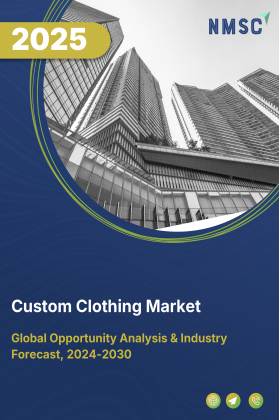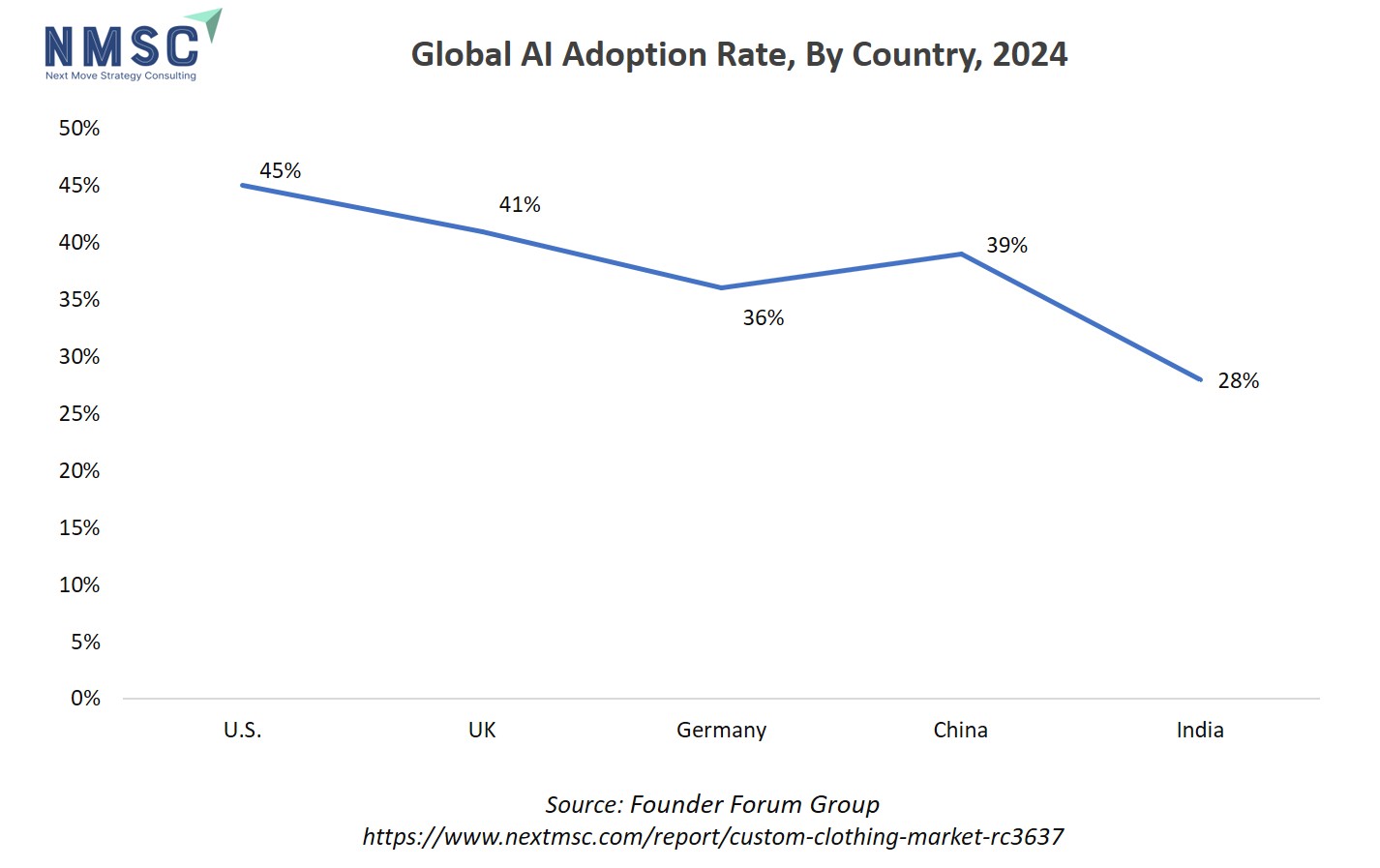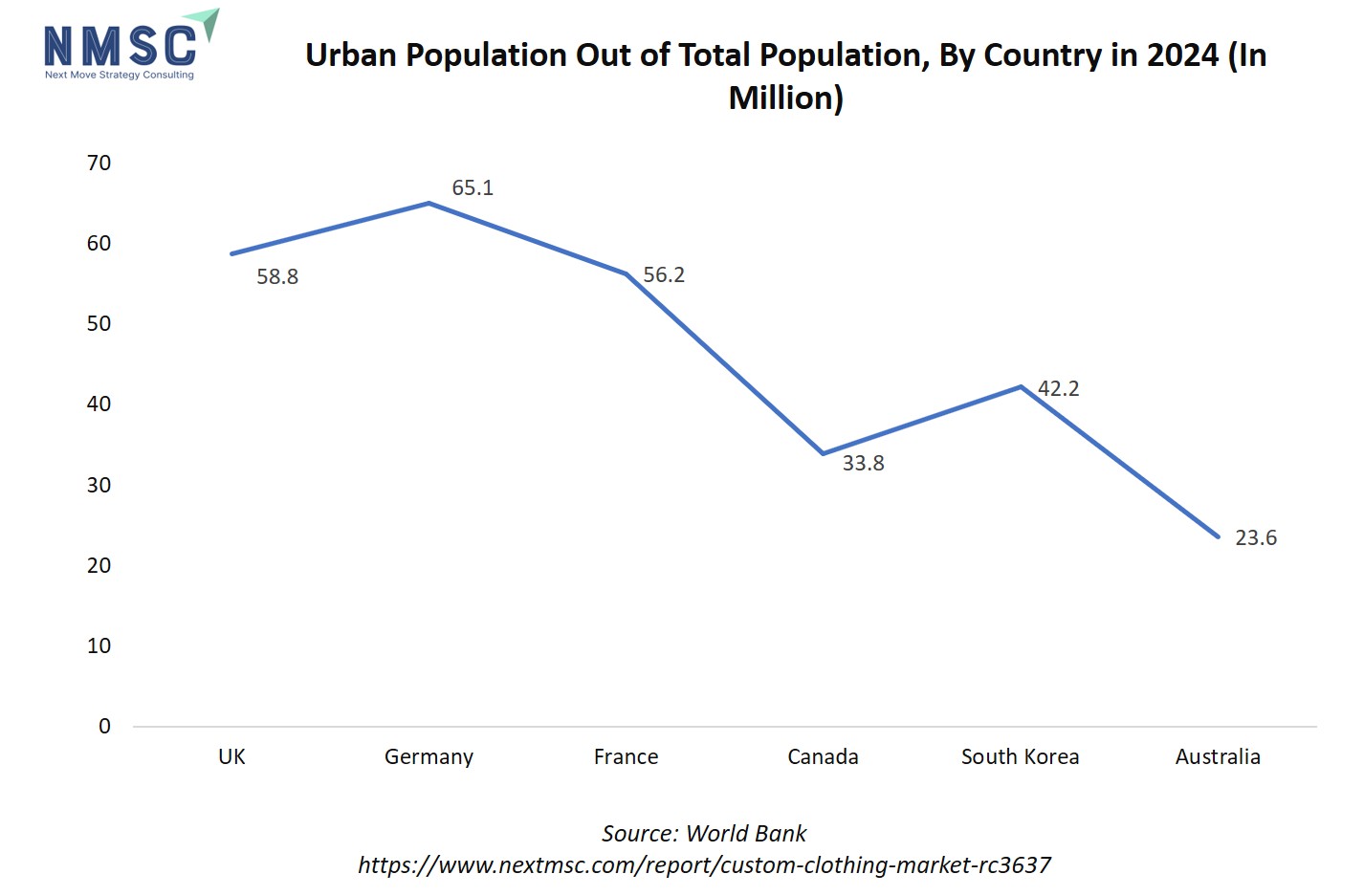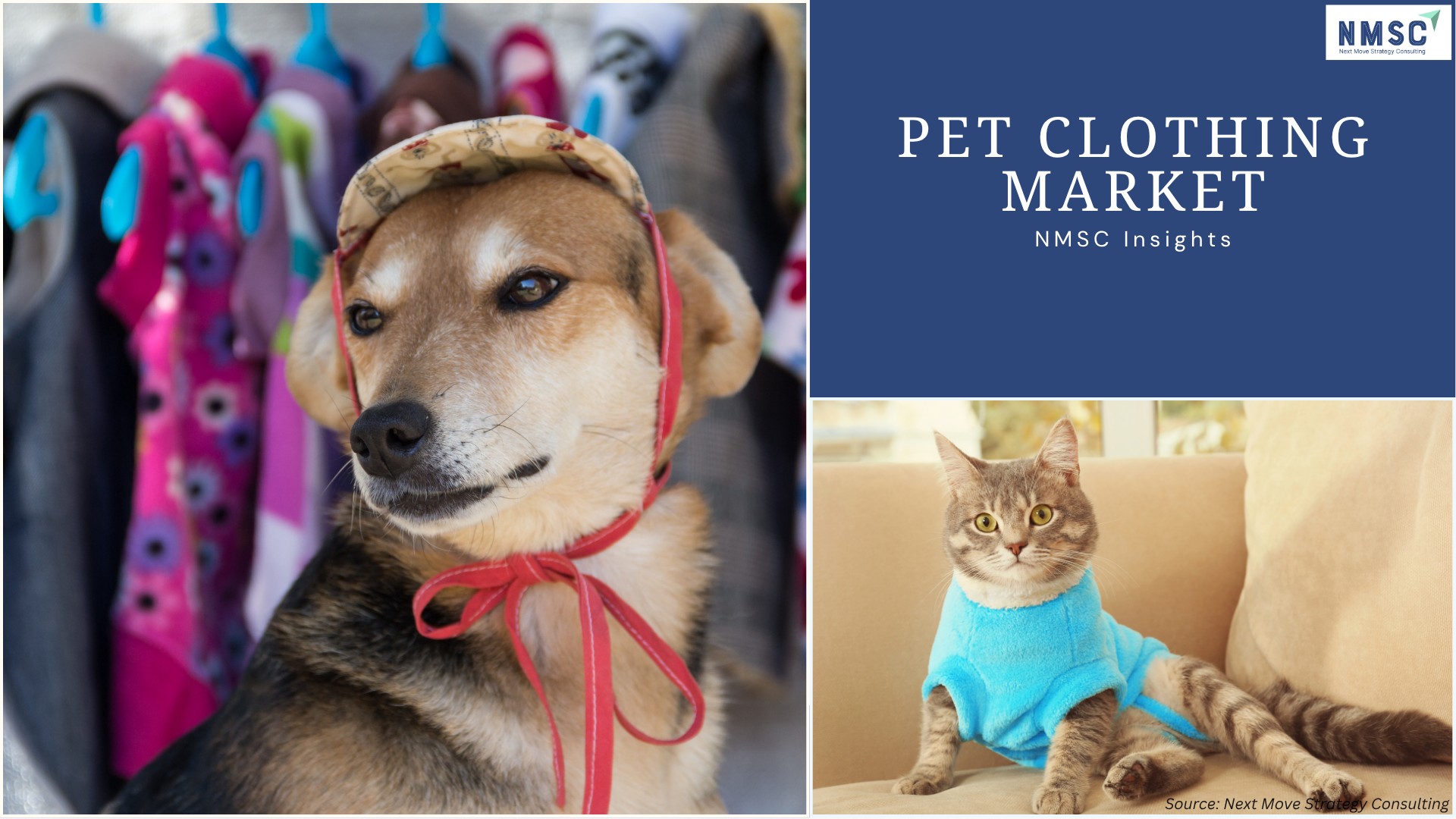
Custom Clothing Market By Apparel Type (Suits and Shirts, T-shirts & Dresses, and Others), By Accessories (Headwear, Bags, and Others), By Material Type (Cotton and Natural Fabrics, Wool & Other Animal Fibers, and Others), By Design Type(Graphic Design And Artwork, Logo and Text Only, and Others), By Customization Approach (Made to Measure, Custom Tailoring, and Others), By End-User (Online, and Offline (Specialty Stores, Brand Outlets, and Tailoring Shops)–Global Analysis & Forecast, 2025–2030
Industry Outlook
The global Custom Clothing Market size was valued at USD 55.04 billion in 2024, and is expected to be valued at USD 61.49 billion by the end of 2025. The industry is projected to grow, hitting USD 107.07 billion by 2030, with a CAGR of 11.7% between 2025 and 2030.
Custom clothing has evolved from niche bespoke tailoring into a dynamic segment driven by consumer demand for personalization, fit, and unique expression. Advances in digital manufacturing, on-demand production, and online design platforms have lowered barriers for small brands and individual consumers to create one-of-a-kind pieces or small batches. Brands leverage data-driven sizing algorithms, 3D body scanning, and automated cutting to reduce waste and speed delivery while preserving artisanal value. Rising awareness of sustainable practices and preference for quality over quantity further boost custom options. At the same time, supply chain flexibility and localized production hubs enable faster turnaround and lower inventory risk.
Market participants range from independent tailors and niche designers to established apparel brands and digital platforms that connect customers with makers. Segmentation typically includes made-to-measure, bespoke, mass customization, and print-on-demand services across menswear, womenswear, childrenswear, and performance apparel categories. Distribution spans direct-to-consumer ecommerce, branded boutiques, white label manufacturing for retailers, and corporate or event uniform contracts. Key challenges include scaling personalization profitably, managing returns and alterations, and ensuring consistent quality across diverse production partners. Opportunities lie in vertical integration, augmented reality fitting, and targeted marketing that converts higher lifetime value customers through loyalty and differentiated offerings.
Also, internet penetration acts as a crucial driver for the growth of the custom clothing market demand by enabling widespread access to online platforms where customers can design, customize, and order apparel tailored to their preferences. With increased mobile internet availability, consumers can easily engage with AI-powered tools that offer virtual try-ons, personalized style suggestions, and seamless e-commerce experiences, even on the go. This accessibility democratizes custom-made clothes, reaching markets beyond traditional retail hubs and allowing brands to tap into diverse demographics worldwide. As mobile connectivity expands, particularly in emerging markets, it fosters greater consumer interaction with digital fashion services, accelerating market growth by enhancing convenience, choice, and real-time engagement.
In the above chart, high penetration rates in North America (80%), Europe & Central Asia (75%), and Asia Pacific (72%) enable consumers in these regions to easily access online platforms for custom clothing, use mobile design tools, and engage with e-commerce features like virtual fitting and personalization, thereby driving robust market expansion.
What are the Key Custom Clothing Industry Trends?
How is Digital Customization Reshaping the Custom Clothing Market?
The custom clothing market is experiencing a significant transformation due to advancements in digital customization technologies. This growth is fueled by the increasing demand for personalized clothing and the rise of online platforms that offer customization options. Brands are leveraging digital tools like 3D design software and virtual fitting rooms to enhance the customer experience and streamline the customization process. Embracing digital customization technologies is crucial to staying competitive. Investing in user-friendly online platforms and integrating advanced design tools can attract tech-savvy consumers seeking personalized apparel. Additionally, utilizing data analytics can help brands understand customer preferences and trends, enabling them to offer targeted customization options.
What Role does Sustainability Play in the Custom Clothing Market Growth?
Sustainability has become a key driver in the market, with consumers increasingly prioritizing eco-friendly practices and materials. Brands are adopting sustainable practices such as using organic fabrics, implementing waste-reducing manufacturing processes, and offering recycling programs to appeal to environmentally conscious consumers. Integrating sustainability into their business models is essential for long-term success. This can involve sourcing materials from sustainable suppliers, minimizing waste through efficient production techniques, and promoting transparency in the supply chain. By aligning with consumer values and demonstrating a commitment to environmental responsibility, brands can build trust, enhance their reputation, and attract a loyal customer base.
How is Personalization Influencing Consumer Behaviour in the Custom Clothing Market?
Personalization is increasingly influencing consumer behaviour in the market, with customers seeking unique and tailored apparel that reflects their individual styles. Consumers are utilizing online platforms to design custom garments, incorporating elements such as monograms, graphics, and personalized messages. Offering personalized options can enhance customer engagement and drive sales. Implementing intuitive design tools on e-commerce platforms allows customers to easily create their desired apparel, leading to increased satisfaction and repeat business. Additionally, leveraging customer data to offer personalized recommendations can further enhance the shopping experience. By focusing on personalization, brands can differentiate themselves in a competitive market and build strong, lasting relationships with their customers.
How are Emerging Technologies Transforming the Custom Clothing Market?
Emerging technologies are playing a pivotal role in transforming the market, enabling brands to offer innovative products and services. Advancements in digital printing technologies, such as direct-to-garment (DTG) and sublimation printing, allow for high-quality, detailed designs on custom apparel. These technologies enable quick turnaround times and the ability to produce small batches, catering to the growing demand for personalized clothing. Additionally, the integration of artificial intelligence (AI) and machine learning is enhancing design processes and customer interactions. adopting emerging technologies is essential to remain competitive and meet evolving consumer expectations. Investing in advanced printing equipment and AI-driven design tools can streamline operations and improve product offerings. Furthermore, incorporating technologies like augmented reality (AR) for virtual try-ons can enhance the online shopping experience, reduce return rates and increase customer satisfaction.
The chart, which presents the 2024 AI adoption rate across key global markets, directly impacts the growth trajectory of the market. Higher AI adoption rates in countries like the U.S. (45%) and the UK (41%) suggest advanced digitalization within their retail and manufacturing sectors, facilitating enhanced personalization, digital design automation, recommendation engines, and supply chain optimization for custom clothing. As companies in these markets increasingly leverage AI-driven tools, such as virtual fitting, predictive design, and individualized style profiling, the custom clothing sector is likely to experience strong growth fueled by consumer demand for unique products and seamless digital experiences. In contrast, countries with lower AI adoption rates, such as India (28%), may see slower integration of these technologies, potentially limiting custom clothing market expansion relative to higher-adoption regions.
What are the Key Market Drivers, Breakthroughs, and Investment Opportunities that will Shape the Custom Clothing Industry in the Next Decade?
The market is experiencing significant growth, driven by evolving consumer preferences, technological advancements, and the increasing demand for personalized apparel. This surge is fueled by millennials' preference for personalized clothing, with 72% of demand driven by this demographic. However, the market faces challenges such as high production costs and supply chain inefficiencies, particularly impacting small and medium-sized enterprises (SMEs). Despite these hurdles, opportunities abound in areas like sustainability, technological innovation, and emerging markets, which can propel the industry forward
Growth Drivers:
How are Technological Innovations and Digital Platforms Accelerating the Adoption of Custom Clothing?
Technological innovations are reshaping the custom clothing landscape, making personalized apparel more accessible and cost-efficient. Tools like 3D body scanning, AI-driven design software, and digital printing enable precise measurements and highly detailed designs while reducing production waste. The rise of online customization platforms allows consumers to create unique garments from home, combining convenience with creative control. Companies embracing digital solutions can attract tech-savvy consumers, improve operational efficiency, and strengthen brand loyalty.
How is the Rising Consumer Preference for Personalized and Expressive Apparel Driving Market Growth?
Consumer demand for personalization is a major driver of market growth, as individuals seek garments that reflect their personality, values, and style. Millennials, in particular, account for 72% of demand for custom clothing. Brands are responding by offering options such as monograms, unique prints, tailored fits, and interactive online design tools. This focus on personalization enhances customer engagement, satisfaction, and repeat purchases, while also fostering brand loyalty. Companies that invest in seamless customization experiences and predictive analytics to understand individual preferences can capture higher-value customers and differentiate themselves in the increasingly competitive custom clothing market.
The number of social media users acts as a powerful driver for the custom clothing market by serving as a dynamic platform for fashion discovery, brand engagement, and personalized marketing. Social media channels amplify consumer trends, enable real-time sharing of unique style inspirations, and facilitate direct interaction between brands and customers, encouraging demand for customization. Influencers and micro-influencers play a critical role in showcasing custom clothing, thereby enhancing brand visibility and driving consumer interest. Additionally, social media's visual and interactive nature supports virtual try-ons and user-generated content, cultivating a highly engaged audience that fuels the growth of the market globally.
The steady year-over-year growth in social media engagement creates an expanding digital ecosystem where fashion brands can showcase personalized clothing options, leverage user-generated content, and implement targeted advertising campaigns for custom apparel.
Growth Inhibitors:
What are the Key Cost and Operational Challenges Restraining Growth in the Custom Clothing Market?
High production costs and supply chain inefficiencies remain critical barriers for market growth, particularly for SMEs. Customized apparel often requires specialized equipment, skilled labor, and small-batch production, resulting in higher per-unit costs. These challenges impact scalability and profitability. Companies must adopt strategies such as investing in automation, optimizing logistics, and leveraging localized production hubs to reduce costs and enhance efficiency while maintaining quality, enabling broader market penetration and sustainable growth.
Which Emerging Investment Opportunities in Sustainable and Tech-Enabled Custom Clothing are Promising for Future Growth?
Sustainability and technological innovation present strong investment opportunities in the custom clothing market. Consumers increasingly prefer eco-friendly materials, ethical production, and transparent supply chains, creating demand for sustainable apparel options. Technological advancements, including AI-driven design, digital printing, and virtual fitting rooms, allow brands to reduce waste, accelerate production, and enhance the customer experience. Companies investing in these areas can differentiate themselves, attract environmentally conscious consumers, and capitalize on long-term growth trends in the custom clothing industry.
How Custom Clothing Market Segmented in this Report, and What are the Key Insights from the Segmentation Analysis?
By Apparel Type Insights
Is there a Rising Demand for Custom Suits and Shirts over Other Product Types?
On the basis of apparel type, the market is segmented into suits and shirts, t-shirts & dresses, pants & coats, ties & scarves denim, skirts, and others.
Suits and shirts are leading segments in the market. The demand for custom suits and shirts is driven by professionals seeking personalized fits and styles that align with their individual preferences. Also, there is a growing demand for custom t-shirts and dresses. These items are popular for everyday wear and are often customized with unique designs or messages. The rise of online platforms and digital printing technologies has made it easier for consumers to design and order personalized t-shirts and dresses.
Pants and coats are significant segments in the custom clothing market. These items are essential for both casual and formal wardrobes, offering customization in fit and style. The demand for custom pants and coats is driven by consumers seeking personalized fits and styles that align with their individual preferences. Other custom clothing items, including hoodies, jackets, and activewear, cater to niche markets and are experiencing steady growth. These items offer customization in fit and style, appealing to consumers seeking personalized apparel.
By Accessories Insights
How is the Custom Clothing Market Segmented by Accessories?
Based on accessories, the market is segmented into headwear, bags, gloves, belts, cravats, and others.
Headwear, including caps, hats, and beanies, is a leading segment in custom accessories. Its popularity is driven by the ability to combine fashion with brand expression, especially among younger consumers. Digital printing and embroidery technologies allow intricate designs, logos, and patterns, making headwear a key personalization category. Companies can capitalize on this by offering seasonal collections and limited-edition designs.
Custom bags, including backpacks, handbags, and totes, are gaining traction due to their utility and visibility. Personalized bags allow consumers to showcase individuality through monograms, color choices, and material selection. As digital printing and laser engraving technologies advance, production costs are lowering, making bespoke bags more accessible.
By Material Type Insights
Which Materials are Shaping the Future of the Custom Clothing Market?
Based on material type, the market is divided into cotton and natural fabrics, wool and other animal fibers, silk and luxury natural fibers, linen, and others.
Cotton and other natural fabrics account for the largest share of the custom clothing market, primarily due to affordability, comfort, and versatility across multiple product types. This dominance is reinforced by consumer preference for breathable, easy-care materials that suit everyday fashion and mass customization needs. Wool and other animal fibers are a niche but growing segment in the custom clothing market share, particularly for winter apparel, formal wear, and premium garments. These fibers are preferred for their warmth, texture, and luxurious feel.
Silk and luxury natural fibers cater to the high-end and bespoke segment, providing exclusivity, premium texture, and aesthetic appeal. These materials account for roughly a low percentage of custom clothing consumption and are highly favored in dresses, scarves, and special-occasion wear. Consumer demand is driven by the desire for personalized, luxurious garments with superior comfort and elegance.
By Design Type Insights
Which Design Types are Driving Personalization in the Custom Clothing Market?
Based on design type, the market is divided into graphic design and artwork, logo and text only, and pattern and cut customization.
Graphic design and artwork is a leading design type in custom clothing, especially for casual wear, streetwear, and youth fashion. Consumers are increasingly leveraging digital tools to apply illustrations, digital art, and unique visuals to garments. Logo and text customization is highly relevant for corporate, promotional, and event apparel, allowing organizations to showcase branding or messaging.
Pattern and cut customization focuses on tailoring garments to precise fit, style, and fabric combinations. This segment caters primarily to premium, bespoke, and made-to-measure customers.
By Customization Approach Insights
Which Customization Approaches are Transforming the Custom Clothing Market Trends?
Based on customization approach, the market is segmented into made to measure, custom tailoring, and personalization and print on demand.
Made-to-measure garments are increasingly popular for consumers seeking a balance between personalization and affordability. This approach allows modifications in size, fit, and minor design elements without the full cost or lead time of bespoke tailoring.
Custom tailoring, on the other hand, caters to high-end consumers who demand fully bespoke garments. Every measurement, fabric, and cut is personalized, providing a luxury and exclusive experience. Personalization and print-on-demand (POD) is a fast-growing segment, enabling consumers to customize ready-made garments with graphics, text, and designs via online platforms. POD reduces inventory risk and allows brands to cater to digital-native audiences.
By Price Tier Insights
Which Price Segments are Shaping Consumer Choices in the Custom Clothing Market?
Based on price tier, the market is segmented into luxury and premium, mid-market, and value economy.
Luxury and premium custom clothing represents the high-end segment, characterized by exclusive fabrics, full bespoke tailoring, and personalized experiences. The mid-market segment offers a balance between quality, customization, and affordability. Products in this segment often include made-to-measure suits, custom shirts, and semi-bespoke casual wear. The value economy segment targets price-sensitive consumers who still desire personalized apparel. This segment relies heavily on online platforms, print-on-demand technologies, and limited customization features. Its growth is driven by the increasing accessibility of e-commerce and younger consumers exploring affordable personalization options.
By Sales Channel Insight
Which Sales Channels are Driving Consumer Engagement in the Custom Clothing Market?
Based on sales channel, the market is bifurcated into online, and offline.
Online channels are experiencing rapid growth due to the convenience, reach, and interactive customization tools they offer. Consumers can design, visualize, and order personalized apparel from home, with options like 3D body scanning, AR try-ons, and print-on-demand. However, despite the rise of online sales, offline channels remain relevant, especially for premium, bespoke, and made-to-measure garments. Physical stores and tailor shops provide personalized consultations, fittings, and a tactile experience that many consumers value.
Regional Outlook
The market is geographically studied across North America, Europe, Asia Pacific, and the Middle East & Africa, and each region is further studied across countries.
The urban population also acts as a significant driver for the custom clothing market by concentrating a large consumer base with better access to technological infrastructure, higher disposable incomes, and greater fashion consciousness. Urban dwellers are more likely to adopt digital platforms for shopping, enabling easier access to online customization tools, AI-driven design recommendations, and fast delivery services. The dense population in cities also fosters greater exposure to diverse fashion trends and social media influences, which increases demand for personalized and unique clothing options. As urbanization continues globally, the growing urban population fuels market growth by expanding the consumer base that values convenience, customization, and style innovation in their apparel choices.
The chart highlights the size of the urban population for several developed countries in 2024, underscoring a critical demographic advantage for the custom clothing market. Large urban populations in countries like Germany, UK, and France represent dense markets with greater adoption of digital fashion solutions and a higher likelihood of engaging in personalized apparel shopping. These urban centers foster fashion-forward consumer segments who are more connected, tech-savvy, and responsive to customization trends, helping to accelerate growth in the custom clothing sector by driving demand for innovative and personalized style options.
Custom Clothing Market in North America
In North America, the custom clothing market is expanding due to technological innovations such as digital printing, 3D modeling, and AI-based design tools. These advancements have revolutionized the customization process, making it faster, more affordable, and highly accessible to a wide range of consumers. The increasing consumer demand for personalized fashion, coupled with a growing interest in sustainable and ethically produced apparel, is further driving this growth.
Custom Clothing Market in the United States
The U.S. market is heavily influenced by digital innovation and lifestyle trends. Personalized clothing options, online configurators, and AR/VR try-on tools are boosting consumer engagement. Rising disposable incomes, coupled with the preference for sustainable, ethical fashion, have increased adoption of custom-made apparel. Digital-first consumers are gravitating toward print-on-demand and semi-bespoke garments, while premium consumers continue to invest in fully tailored clothing. The U.S. market remains one of the largest globally, with technology and sustainability acting as twin growth drivers.
Custom Clothing Market in Canada
Canada's custom clothing market is experiencing growth driven by similar factors as the U.S., including technological advancements and a shift towards personalized fashion. The country's diverse and multicultural population contributes to a demand for unique and culturally relevant designs. Moreover, the increasing awareness of environmental issues is prompting Canadian consumers to seek sustainable and ethically produced custom apparel.
Custom Clothing Market in Europe
Europe maintains a stronghold in the custom clothing market, with consumers placing high value on craftsmanship, quality, and sustainability. Luxury markets in Italy, France, and Germany are expanding through bespoke tailoring, pattern customization, and high-end fabric selection. Technological adoption, such as 3D scanning and virtual fittings, complements traditional tailoring practices, offering a hybrid solution for consumers. Sustainability initiatives, ethical manufacturing, and cultural appreciation for heritage brands further fuel demand, making Europe a leader in combining traditional and modern customization approaches.
Custom Clothing Market in the United Kingdom
The UK’s market is shaped by a long-standing tailoring tradition and rising interest in digital personalization. Consumers increasingly use online platforms for made-to-measure suits, custom shirts, and bespoke casual wear. Sustainability remains a key driver, with eco-conscious buyers preferring garments that align with ethical and environmental standards. Seasonal and event-based customization is growing, and retailers are leveraging AI design tools to create unique offerings. The combination of heritage tailoring and modern technology is strengthening the UK’s presence in Europe’s custom apparel landscape.
Custom Clothing Market in Germany
Germany’s market is characterized by precision, quality, and technical innovation. Consumers prefer made-to-measure and bespoke garments with impeccable fit, particularly in formalwear and outerwear. Digital printing and AI-assisted design tools are increasingly integrated into the customization workflow, allowing brands to scale offerings without compromising quality. Sustainability awareness drives demand for ethically produced fibers and locally sourced materials. Germany’s focus on innovation and craftsmanship makes it a strong market for both mid-market and premium custom apparel, balancing efficiency with high-quality bespoke experiences.
Custom Clothing Market in France
France’s custom clothing market thrives on fashion heritage and luxury branding. Bespoke tailoring, premium fabrics, and designer collaborations are key growth drivers. Online platforms have expanded accessibility, allowing younger, digital-savvy consumers to engage in personalization. Sustainability initiatives, such as repair bonuses and eco-friendly materials, are gaining traction. Consumers increasingly value ethically produced garments that retain aesthetic appeal. France’s high-end market continues to set trends for luxury customization, while mid-market and digital-first segments are growing steadily due to the combination of technological adoption and heritage-driven fashion appreciation.
Custom Clothing Market in Spain
Spain’s market is expanding as digital platforms and social media drive interest in personalized fashion. Consumers seek garments that reflect individual style while aligning with sustainability preferences. Mid-market customization, including made-to-measure and semi-bespoke clothing, is growing in popularity, while luxury bespoke garments cater to premium consumers. The increasing awareness of environmental issues is prompting local brands to offer eco-friendly fabrics and designs. Social media influence accelerates trends adoption, making Spain a dynamic and culturally responsive custom apparel market.
Custom Clothing Market in Italy
Italy remains a cornerstone for premium custom apparel, blending centuries-old craftsmanship with modern digital customization. Consumers favor high-quality fabrics, precise tailoring, and bespoke patterns. Technological innovations, including virtual fittings and AI-based design, are facilitating easier access to personalized fashion. Sustainability initiatives, such as organic and recycled fibers, are shaping purchasing behavior. Italy’s combination of luxury heritage, artisan skills, and innovative digital tools ensures continued growth, particularly in bespoke suits, coats, and high-end dresses.
Custom Clothing Market in the Nordics
The Nordics are witnessing strong growth in custom clothing, driven by sustainability, ethical production, and technological adoption. Consumers prioritize eco-friendly fabrics, low-waste manufacturing, and personalized, high-quality garments. Online platforms and digital tools facilitate made-to-measure and print-on-demand options, making bespoke fashion accessible even in smaller markets. Cultural preferences for minimalist, functional, and sustainable design reinforce this trend. The Nordics demonstrate that combining digital customization with environmental responsibility can accelerate growth and brand loyalty in mature, eco-conscious markets.
Custom Clothing Market in Asia Pacific
Asia-Pacific is experiencing rapid expansion due to rising disposable incomes, a growing middle class, and a strong fashion-conscious youth population. Countries like China, Japan, India, and South Korea are embracing digital tools for customization, including AI-based design, AR/VR try-ons, and 3D printing. Social media influences consumer choices, boosting demand for personalized apparel. Manufacturing advancements reduce lead times and costs, making bespoke options more accessible. Sustainability and ethical production are emerging factors in urban centers, further fueling the growth of the region’s custom clothing market.
Custom Clothing Market in China
China’s market is growing due to a tech-savvy population, rising disposable incomes, and the popularity of online shopping. Consumers increasingly demand personalized apparel through digital platforms that offer graphics, text, and made-to-measure options. Social media and influencers play a strong role in shaping trends, while digital printing and AI-assisted production streamline customization. Urban youth and middle-class consumers are particularly receptive to bespoke fashion. Sustainability awareness is growing slowly but is becoming a differentiating factor for premium brands.
Custom Clothing Market in Japan
Japan’s market combines traditional craftsmanship with modern technology. Bespoke tailoring remains highly valued, while online customization platforms enable broader access. Consumers appreciate high-quality fabrics, precise patterning, and garments reflecting individual style. The market is influenced by technological integration, such as AR fitting and digital printing, which improve convenience without compromising quality. Sustainability and slow fashion trends are emerging factors, particularly in urban areas. Japan represents a mature market with a balance of high-end bespoke and mid-market personalized apparel.
Custom Clothing Market in India
India’s market is rapidly growing, fueled by an expanding middle class, urbanization, and rising disposable incomes. Consumers increasingly seek premium, tailored, and personalized apparel. Digital platforms are enabling online made-to-measure, print-on-demand, and semi-bespoke options. Traditional textile expertise and artisan craftsmanship support bespoke tailoring, while sustainability is gradually influencing purchase decisions. Urban youth and fashion-conscious consumers are driving demand, creating opportunities for both mid-market and luxury segments.
Custom Clothing Market in South Korea
South Korea’s market benefits from a highly fashion-conscious population and rapid digital adoption. Online platforms, mobile apps, and social media influence consumer preferences toward personalized fashion. AI-based design tools, digital printing, and AR try-on features are widely used, supporting both mid-market and premium segments. Consumers increasingly demand unique apparel reflecting personal style, and brands offering customization with sustainable fabrics gain competitive advantage. South Korea represents a technologically advanced, trend-sensitive market for custom clothing.
Custom Clothing Market in Taiwan
Taiwan’s market is shaped by a focus on quality, precision, and innovation. Consumers prefer made-to-measure garments and semi-bespoke options, while digital platforms enhance accessibility. Small-scale brands leverage online customization and print-on-demand solutions to meet urban demand. Sustainability awareness is growing, influencing material choices and production processes. Taiwanese consumers value fit, fabric quality, and individuality, making the market attractive for mid-market and premium custom apparel providers.
Custom Clothing Market in Indonesia
Indonesia’s young, fashion-conscious population is fueling demand for custom clothing. Social media trends, influencer marketing, and e-commerce adoption are driving interest in personalized apparel. Consumers increasingly use online platforms for graphics, patterns, and text customization, while made-to-measure garments are emerging in urban centers. Affordable digital customization tools are enabling wider access. Sustainability is an emerging factor, but the primary growth driver remains the youthful population seeking unique and expressive clothing.
Custom Clothing Market in Australia
Australia’s market is expanding as fashion-forward consumers adopt digital personalization tools and made-to-measure apparel. Sustainability and ethical production influence consumer choices, particularly in urban centers. Online platforms enable print-on-demand and semi-bespoke offerings, while luxury consumers continue to demand fully tailored garments. The combination of tech adoption, environmental awareness, and appreciation for high-quality fabrics is accelerating growth. Consumers are increasingly looking for clothing that combines individual style, sustainability, and convenience.
Custom Clothing Market in Latin America
Latin America is emerging as a promising market, with urbanization, rising disposable incomes, and growing digital retail infrastructure driving demand for custom clothing. Consumers are increasingly seeking personalized, stylish garments that align with ethical and sustainable practices. Social media and influencer campaigns accelerate trend adoption. Countries like Brazil and Mexico are key growth markets, where mid-market and premium segments are expanding rapidly. The region presents opportunities for brands to leverage digital platforms and e-commerce for made-to-measure and print-on-demand solutions.
Custom Clothing Market in the Middle East & Africa
The Middle East and Africa are niche but growing markets for custom clothing. In the Middle East, affluent consumers in the UAE, Saudi Arabia, and Qatar seek bespoke, high-quality garments that reflect cultural and personal style preferences. Digital platforms and luxury customization services are gaining traction. In Africa, urban centers are witnessing increasing interest in personalized apparel, though growth is limited by infrastructure and investment challenges. Cultural traditions, rising fashion consciousness, and an emerging middle class are driving adoption, creating a gradual but steady market expansion.
Competitive Landscape
Which Companies Dominate the Custom Clothing Market and How do They Compete?
The custom clothing market features a mix of global giants and specialized players, including Indochino, Brooks Brothers, Tailor Store, Uniqlo, and others. Companies compete on multiple fronts, such as digital customization platforms, product variety, quality of fabrics, and personalization speed. Online configurators, AR/VR fittings, and made-to-measure services are increasingly differentiating brands. Giants leverage scale, marketing power, and global distribution, while specialists focus on niche segments, bespoke services, and localized offerings. This competition has accelerated innovation in digital tools, customer experience, and sustainable production practices, allowing players to capture diverse consumer segments and retain loyalty.
Market Dominated by Custom Clothing Giants and Specialists
The custom clothing market is shaped by a blend of established giants and niche specialists, each dominating specific states, regions, and consumer segments. Giants like Indochino and Uniqlo leverage their global presence and brand recognition to capture mid-market and premium consumers, whereas specialists focus on bespoke tailoring, luxury fabrics, and highly personalized garments. Regional players in Europe and Asia focus on cultural and fashion preferences, while digital-native brands cater to online-first millennials and Gen Z. This dynamic competition encourages differentiation in design, technology adoption, and sustainability, ensuring the market remains segmented yet highly competitive across various price tiers and niches.
Innovation and Adaptability Drive Market Success
Innovation and adaptability have become critical for market players to succeed in custom clothing. Companies are introducing AI-assisted design platforms, AR/VR fitting rooms, 3D body scanning, and print-on-demand technology to enhance consumer engagement. Some players are also integrating sustainable fabrics and zero-waste production to meet growing eco-conscious demand. Tailor Store and Indochino, for instance, offer fully digital made-to-measure services, while Levi’s allows consumers to customize jackets with embroidery or graphics. These innovations not only improve customer experience but also increase operational efficiency and scalability, enabling brands to compete effectively in both luxury and mass-market segments.
Market Players to OPT for Merger & Acquisition Strategies to Expand their Presence
In the custom clothing market, companies are leveraging strategic investments and partnerships to strengthen their presence and enhance capabilities. Indochino, for example, raised USD 30.2 million from China’s Dayang Group, enabling the brand to expand fabric selections, introduce new suit silhouettes, and improve online customization services. Additionally, Indochino has expanded its retail footprint through partnerships, such as opening five new shop-in-shops with Nordstrom in 2025, bringing the total to 38 locations, offering personalized fittings and enhanced customization options. These strategies allow companies to grow market share, enhance customer experience, and integrate innovative digital solutions without relying solely on acquisitions.
List of Key Custom Clothing Companies
-
L & K Custom Tailor
-
Dress2kill Ltd
-
Custom Ink
-
Brooks Brothers
-
RJ MTM (RJ MTM / RJMTM)
-
Apposta Ltd
-
Zega Apparel
-
Tailor Store
-
CustomCat’s
-
Royal Apparel
-
Uniqlo
-
Billoomi Fashion
-
Sene
-
Cad and the Dandy
What are the Latest Key Industry Developments?
-
August 2025- Indochino announced the opening of five new shop-in-shop locations within Nordstrom stores across the U.S., including Aventura Mall (Florida), Boca Raton (Florida), Park Meadows (Colorado), Woodfield (Illinois), and Southcenter Mall (Washington). This expansion brings the total number of Indochino shop-in-shops within Nordstrom stores to 38, reinforcing their commitment to personalized style and exceptional customer service.
-
December 2024- L & K Bespoke Tailor, based in Hong Kong, shared insights on the journey of men's suit tailoring, emphasizing the importance of alterations for a perfect fit and comfort. This initiative aims to educate customers on the tailoring process, enhancing their overall experience and satisfaction.
-
June 2024- RJ MTM, a global custom suit manufacturer, expanded its wholesale offerings, providing private-label services to menswear businesses. With two-piece suits starting at USD 165 USD, RJ MTM aims to make custom tailoring accessible to a broader market, catering to both established brands and startups.
-
May 2024- Apposta, an Italian custom shirt manufacturer, introduced new features to its online platform, allowing customers to design shirts with a wider range of fabrics and styles. The platform also offers a Perfect-Fit Guarantee, ensuring customer satisfaction with their made-to-measure shirts.
-
January 2024- Custom Ink announced the launch of a sustainable product line, featuring eco-friendly materials and designs. This move aligns with the growing consumer demand for environmentally conscious products and positions Custom Ink as a leader in sustainable custom apparel.
What are the Key Factors Influencing Investment Analysis & Opportunities in the Custom Clothing Market?
Investment in the market is being driven by rapidly evolving consumer preferences for personalized and expressive apparel, which has attracted both venture capital and strategic investors. Funding trends indicate a surge in early-stage investments for technology-driven platforms offering AI-based customization, 3D fitting, and on-demand manufacturing, reflecting a shift toward scalable, digital-first solutions. Valuations for companies in this segment are rising as investors increasingly prioritize brands that combine strong online presence with sustainable and efficient production models.
Key investment hotspots include North America and Europe, where digital adoption and disposable income support premium personalization, as well as emerging markets in Asia-Pacific, where growing fashion consciousness and e-commerce penetration present high growth potential. Opportunities lie in platform-based marketplaces, sustainable material innovation, and AI-driven design tools, offering attractive returns for investors looking to capitalize on the convergence of technology and fashion personalization.
Key Benefits for Stakeholders:
Next Move Strategy Consulting (NMSC) presents a comprehensive analysis of the market, covering historical trends from 2020 through 2024 and offering detailed forecasts through 2030. Our study examines the market at country levels, providing quantitative projections and insights into key growth drivers, challenges, and investment opportunities across all major personalized apparel segments.
The market is entering a transformative phase driven by technological innovation, changing consumer preferences, and increasing demand for personalized apparel. Companies that leverage digital platforms, AI-driven customization, and on-demand manufacturing are gaining a competitive edge, attracting both venture capital and strategic investors. Sustainable production and eco-friendly materials are becoming critical differentiators, aligning brand value with consumer expectations while supporting long-term growth. Looking ahead, the market offers significant opportunities across mature and emerging regions, particularly in North America, Europe, and the Asia-Pacific. Executives and investors can capitalize on these trends by focusing on scalable technology solutions, expanding into high-demand geographies, and adopting sustainable practices.
Report Scope
|
Parameters |
Details |
|
Market Size in 2025 |
USD 61.49 Billion |
|
Revenue Forecast in 2030 |
USD 107.07 Billion |
|
Growth Rate |
CAGR of 11.7% from 2025 to 2030 |
|
Analysis Period |
2024–2030 |
|
Base Year Considered |
2024 |
|
Forecast Period |
2025–2030 |
|
Market Size Estimation |
Billion (USD) |
|
Growth Factors |
|
|
Countries Covered |
28 |
|
Companies Profiled |
15 |
|
Market Share |
Available for 10 companies |
|
Customization Scope |
Free customization (equivalent to up to 80 analyst-working hours) after purchase. Addition or alteration to country, regional & segment scope. |
|
Pricing and Purchase Options |
Avail customized purchase options to meet your exact research needs. |
|
Approach |
In-depth primary and secondary research; proprietary databases; rigorous quality control and validation measures. |
|
Analytical Tools |
Porter's Five Forces, SWOT, value chain, and Harvey ball analysis to assess competitive intensity, stakeholder roles, and relative impact of key factors. |
Key Market Segments
By Apparel Type
-
Suits and Shirts
-
T shirts & Dresses
-
Pants & Coats
-
Denim
-
Skirts
-
Ties and Scarves
-
Others
By Accessories
-
Headwear
-
Bags
-
Gloves
-
Belts
-
cravats
-
Others
By Material Type
-
Cotton and natural fabrics
-
Wool and other animal fibers
-
Silk and luxury natural fibers
-
Linen
-
Others
By Design Type
-
Graphic design and artwork
-
Logo and text only
-
Pattern and cut customization
-
Others
By Customization Approach
-
Made to Measure
-
Custom Tailoring
-
Personalization and Print on Demand
By Price Tier
-
Luxury and premium
-
Mid-market
-
Value economy
By Sales Channel
-
Online
-
Offline
-
Specialty Stores
-
Brand Outlets
-
Tailoring Shops
-
Conclusion & Recommendations
Our report equips stakeholders, industry participants, investors, policy-makers, and consultants with actionable intelligence to capitalize on Custom Clothing’ transformative potential. By combining robust data-driven analysis with strategic frameworks, NMSC’s custom clothing market report serves as an indispensable resource for navigating the evolving landscape.
The market is at a pivotal stage where personalization, technology integration, and sustainability are converging to redefine consumer expectations and business strategies. Strategic takeaways highlight the importance of digital innovation, with AI-driven design, virtual fittings, and print-on-demand solutions enabling scalable personalization. At the same time, sustainability and ethical sourcing are becoming central differentiators that appeal to conscious consumers. Looking ahead, the market’s future outlook remains strong, with growth driven by rising demand in emerging economies, expanding online channels, and continuous innovation. Companies that embrace adaptability, invest in technology, and align with evolving consumer values are best positioned to capture long-term opportunities.





















 Speak to Our Analyst
Speak to Our Analyst

























